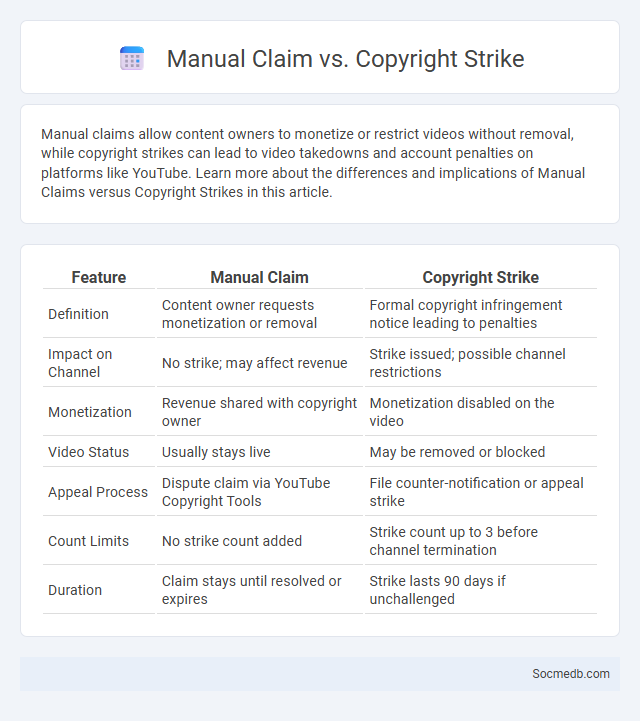
Photo illustration: Manual Claim vs Copyright Strike
Manual claims allow content owners to monetize or restrict videos without removal, while copyright strikes can lead to video takedowns and account penalties on platforms like YouTube. Learn more about the differences and implications of Manual Claims versus Copyright Strikes in this article.
Table of Comparison
| Feature | Manual Claim | Copyright Strike |
|---|---|---|
| Definition | Content owner requests monetization or removal | Formal copyright infringement notice leading to penalties |
| Impact on Channel | No strike; may affect revenue | Strike issued; possible channel restrictions |
| Monetization | Revenue shared with copyright owner | Monetization disabled on the video |
| Video Status | Usually stays live | May be removed or blocked |
| Appeal Process | Dispute claim via YouTube Copyright Tools | File counter-notification or appeal strike |
| Count Limits | No strike count added | Strike count up to 3 before channel termination |
| Duration | Claim stays until resolved or expires | Strike lasts 90 days if unchallenged |
Understanding Copyright on Digital Platforms
Understanding copyright on digital platforms is crucial for protecting your creative work and respecting others' intellectual property rights. Social media sites have specific rules and automated systems to detect unauthorized use of copyrighted content, making it essential to know fair use policies and obtain proper permissions. Your awareness of copyright laws helps avoid legal issues and supports a respectful online community.
What Is a Manual Claim?
A manual claim in social media refers to a content dispute initiated by a rights holder who manually identifies unauthorized use of their intellectual property, such as images, videos, or music, and requests its removal or monetization. You can file a manual claim to protect your original content from infringement and ensure proper credit or compensation. This process is essential for maintaining control over your digital assets and enforcing copyright policies on platforms like YouTube or Instagram.
What Is a Copyright Strike?
A copyright strike occurs when a social media platform removes or restricts content that infringes on someone else's intellectual property rights. Platforms like YouTube, Instagram, and Facebook use automated systems and user reports to detect unauthorized use of copyrighted material, resulting in a strike against the offending account. Accumulating multiple copyright strikes can lead to content takedowns, account suspensions, or permanent bans, emphasizing the importance of respecting copyright laws online.
Manual Claim vs Copyright Strike: Key Differences
Manual claims and copyright strikes serve different purposes in social media content regulation, with manual claims typically allowing content to remain accessible while monetization rights are claimed by the copyright holder. A copyright strike, on the other hand, often results in content removal, account penalties, or even suspension, impacting your channel's standing and visibility. Understanding these distinctions helps you navigate intellectual property rights effectively and maintain compliance with platform policies.
Impact on Content Creators: Manual Claim Consequences
Manual claims on social media significantly affect content creators by limiting monetization opportunities and damaging their reputations through copyright disputes. These claims often result in video demonetization, content removal, or channel strikes, which hinder creators' revenue streams and audience engagement. The increased frequency of false or automated manual claims pressures creators to invest time and resources in dispute resolution, affecting their productivity and content quality.
Impact on Content Creators: Copyright Strike Consequences
Copyright strikes on social media platforms significantly affect content creators by limiting their ability to monetize videos and restricting their access to platform features. Repeated copyright violations can lead to channel suspension or permanent bans, impacting creators' revenue streams and audience engagement. Navigating copyright laws and using original or licensed content is essential for maintaining a sustainable online presence.
Dispute Process: Manual Claim vs Copyright Strike
The social media dispute process differentiates between a manual claim and a copyright strike by the severity and consequences of each action. A manual claim typically involves the content being monetized or restricted without removal, allowing creators to dispute through a claim form, whereas a copyright strike results in content removal and can lead to account penalties or suspension if multiple strikes accumulate. Understanding these distinctions helps users navigate content disputes effectively while protecting their rights and platform standing.
Platform Policies: How YouTube Handles Copyright Issues
YouTube employs a robust copyright management system that utilizes Content ID technology to detect unauthorized use of protected material, allowing copyright holders to claim, monetize, or block infringing content. The platform's strict policies require users to respect intellectual property rights and provide a clear takedown process under the Digital Millennium Copyright Act (DMCA) for rights owners. Your compliance with YouTube's guidelines helps maintain a fair environment, while repeated violations may result in content removal or channel penalties.
Preventing Manual Claims and Copyright Strikes
Preventing manual claims and copyright strikes on social media requires you to understand content ownership and intellectual property rights thoroughly. Implementing proactive measures like using original content, obtaining proper licenses, and utilizing content identification tools can significantly reduce the risk of copyright violations. Monitoring your social media channels regularly helps detect unauthorized use and ensures compliance with platform policies to protect your brand and content.
Best Practices for Managing Copyright Claims
Efficiently managing copyright claims on social media involves promptly addressing takedown notices and understanding the platform's specific copyright policies. Utilizing content identification tools like Content ID on YouTube and Rights Manager on Facebook helps automate claim detection and dispute resolution. Maintaining clear records of content ownership and obtaining proper licenses reduces the risk of infringement and supports swift claim management.
 socmedb.com
socmedb.com